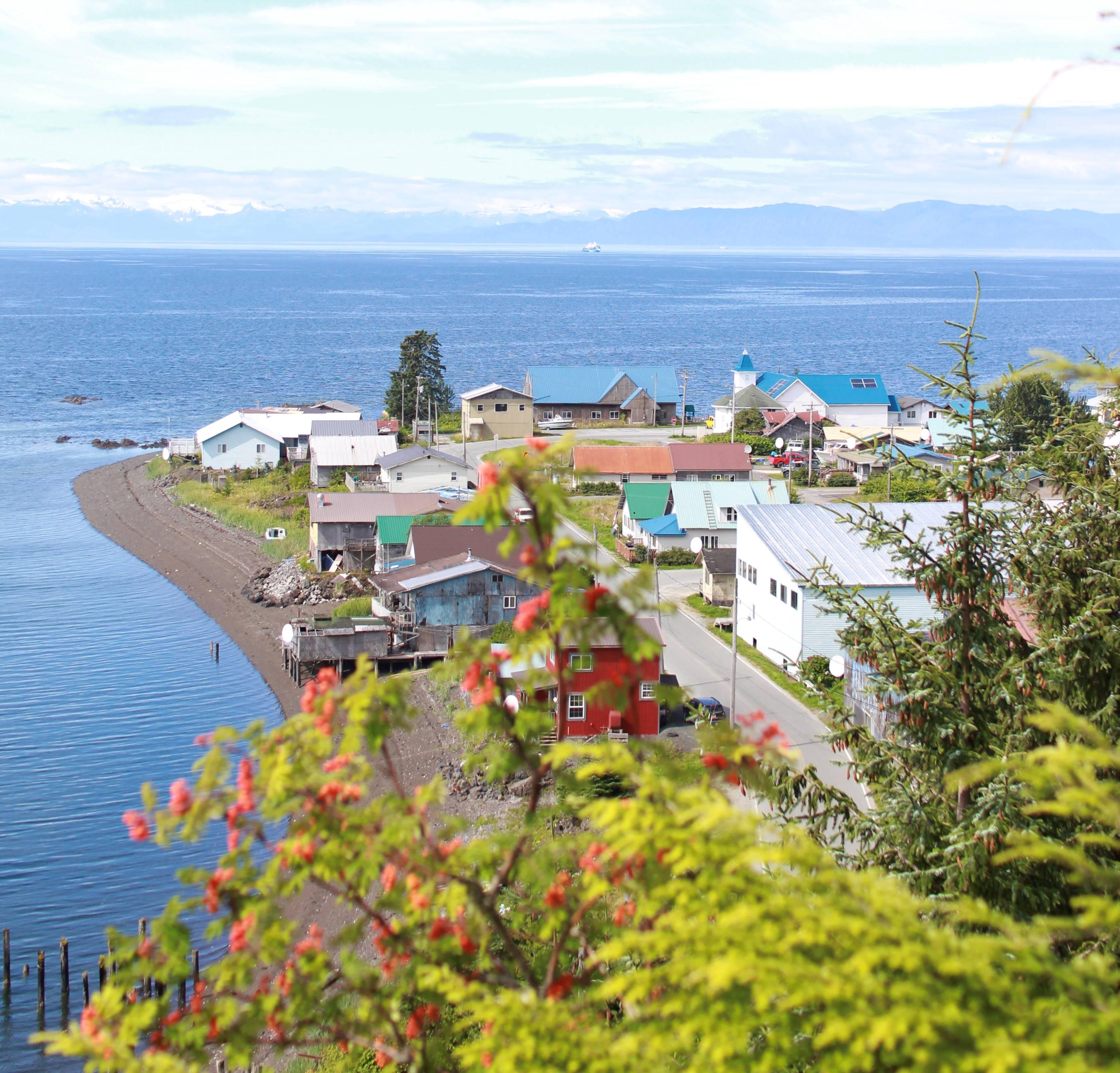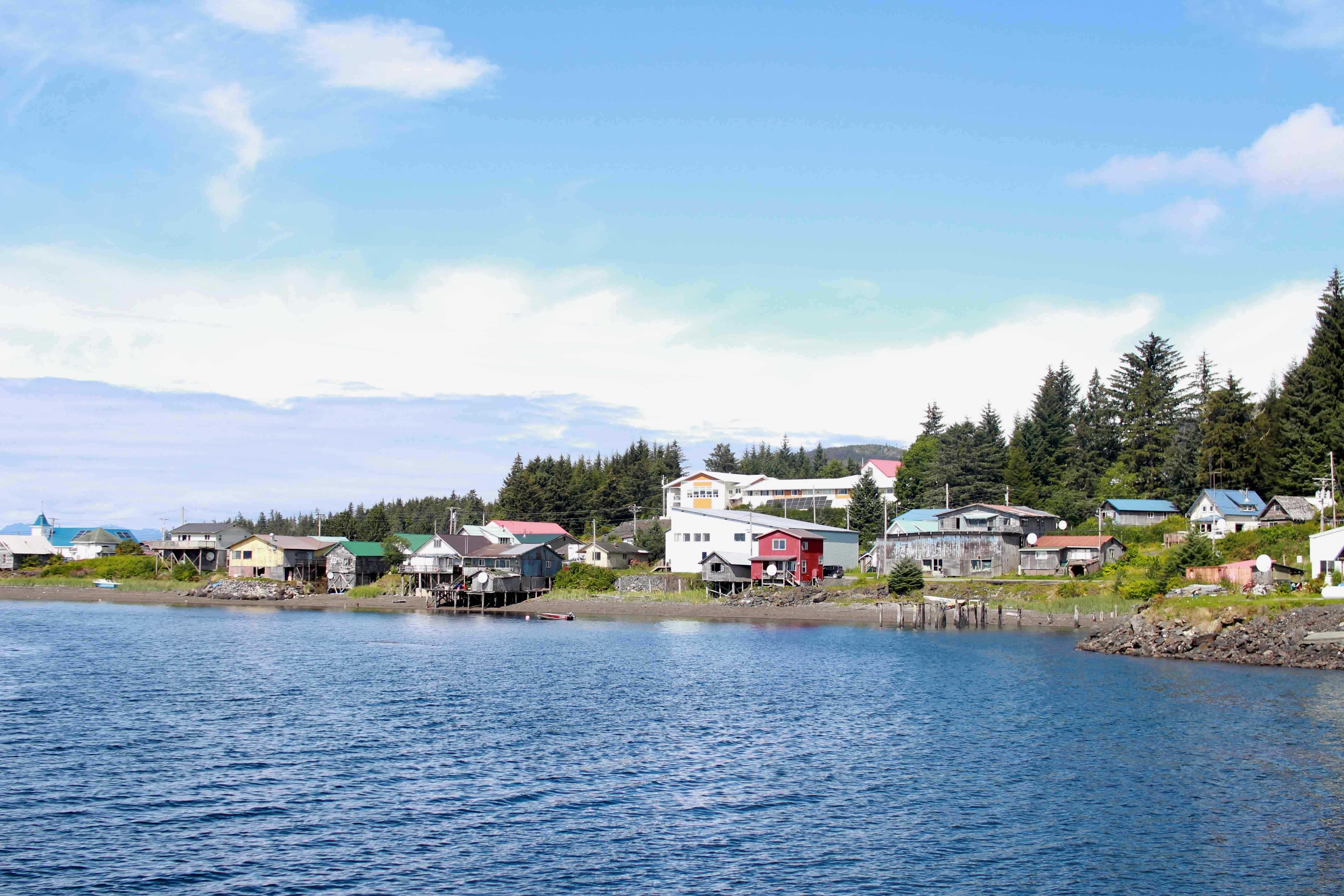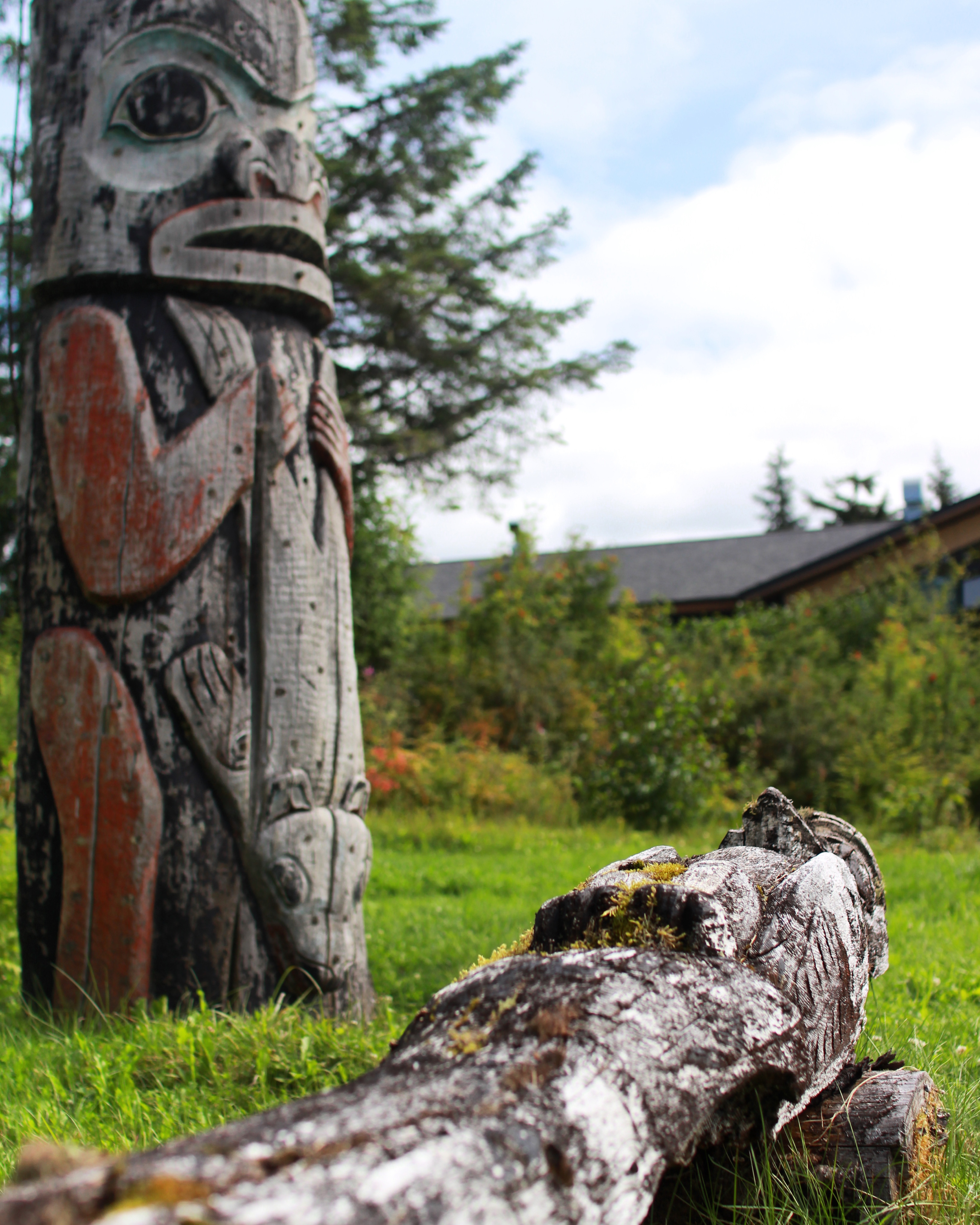
Downtown Kake in the summer. Photo by Shaelene Grace Moler.

Downtown Kake in the summer. Photo by Shaelene Grace Moler.
By Shaelene Grace Moler
Winter 2024-25, FORUM Magazine
I GREW UP HEARING ABOUT the Kake ‘War,’ questioning what was lost, and what I don’t know about my heritage because of it. Historically documented as a ‘war,’ it more accurately is described as the Kake Bombardment by community members– the attack was one-sided with at least 35 clan houses and two forts destroyed, along with all the canoes and food stores that had been cached for the harsh Alaskan winters in the middle of February by the United States. Understanding the full and lasting impacts of the bombardment differs among many, and the intricacies around what happened aren’t fully understood. However, the series of events is generally agreed upon.
If you don’t know of Kake, Alaska, know it is a thriving and close-knit Tlingit community of nearly 600 people located on the northwest coast of Kupreanof Island. Kake is ecologically and culturally abundant with great land and water access, and a thriving community spirit. Surrounded by lush forests, pristine waters, and breathtaking landscapes of Baranof Island’s mountain range, fishing, hunting, and gathering remain central to the community, providing nourishment and connection to the land. The community’s tight-knit nature is evident in the way residents support and uplift one another in both times of hardship and celebration. They live closely connected to the land and each other, fostering a spirit of unity. This is the community I grew up knowing.

Kake oceanfront. Photo by Shaelene Grace Moler.
In 1867, the United States purchased Alaska from Russia, bringing new authority and tension to the Alaska Native communities across the state. As the U.S. military sought to enforce its law system, conflicts between the Tlingit and the military forces began to surface. Among the most significant of these was the series of events that led to what is now known as the "Kake War of 1869" where Kake was bombarded with no retaliation from the Tlingit when it occurred. Kake was one of three Southeast Alaska communities bombed, the others being the Tlingit communities of Angoon and Wrangell.
The conflicts leading up to the “Kake War” began with a confrontation between a U.S. Army soldier and Tlingit leaders following a meeting with General Jefferson C. Davis in Sitka, AK. After the soldier insulted and accosted one leader, Shkeedlikháa, General Davis ordered his capture and locked down Sitka, threatening the Tlingit village with artillery. Under pressure, Shkeedlikháa surrendered to prevent further bloodshed.
After the lockdown was lifted, a U.S. soldier mistakenly shot and killed two unarmed Kake Tlingit people, including Chief Tom's brother. Following Tlingit law, Chief Tom sought compensation from Davis but was denied. To fulfill his obligation for retribution, Chief Tom and his party later encountered four trappers and killed two, viewing the act as a necessary legal response under the Tlingit People’s law system to the deaths of his clan members.

Kake totem pole, one of the largest single tree totem poles in the world. Photo by Shaelene Grace Moler.
Over 150 years after the “Kake War,” Kake has been actively engaging in efforts to heal its community and foster generational abundance, all while recognizing its past.
Upon hearing of the killings, General Davis ordered the destruction of Ḵéex' Ḵwáan villages on both Kuiu and Kupreanof islands. On February 11, 1869, the USS Saginaw, commanded by Lieutenant Commander Richard W. Meade, departed Sitka with instructions to take the Ḵéex' Ḵwáan chiefs hostage and burn their villages to the ground. The destruction began on February 14, when the Saginaw arrived at the first village, Yaandayen Aan, also known as Fossil Bluffs Village. The village was empty, having been vacated by its inhabitants in anticipation of the attack having heard them long before they arrived. The following morning, the soldiers, under Meade's orders, burned the village, including all clan houses, canoes, and food caches. They did this to three villages in total, all deserted in anticipation of the attack.
The survivors of the attack had fled to nearby islands, leaving behind their homes and possessions to protect their families. Some oral history accounts tell of them watching from a distance as their homes were destroyed to avoid further loss of life. Unfortunately, the destruction of their homes and winter food stores left them vulnerable to the elements and starvation, particularly the youth and elderly. Some families could never rebuild; instead, they dispersed and found refuge with other tribes across Southeast Alaska. Most eventually regrouped at the settlement now known as present-day Kake.
Over 150 years after the “Kake War,” Kake has been actively engaging in efforts to heal its community and foster generational abundance, all while recognizing its past. A healing center is being developed and formal apologies are being given. The “Kake War” has left deep scars on the collective memory of the community and understanding that all healing begins somewhere, they received and accepted an apology from the US Navy on September 21, 2024. ■
All information is derived from research by the Organized Village of Kake, Sealaska Heritage Institute, and Zachary R. Jones. Specifically, Jones’ article “‘Search For and Destroy’: US Army Relations with Alaska’s Tlingit Indians and the Kake War of 1869”.
Shaelene Moler is the Communications Catalyst for the Sustainable Southeast Partnership, a collective impact network, who grew up in the community of Kake, AK. She is also a fall 2024 Storytelling Fellow with Alaska Forum Magazine and currently resides in Haines, AK.
FORUM is a publication of the Alaska Humanities Forum. FORUM aims to increase public understanding of and participation in the humanities. The views expressed by contributors are not necessarily those of the editorial staff or the Alaska Humanities Forum.
The Alaska Humanities Forum is a non-profit, non-partisan organization that designs and facilitates experiences to bridge distance and difference – programming that shares and preserves the stories of people and places across our vast state, and explores what it means to be Alaskan.
March 5, 2025 • Polly Carr
February 25, 2025 • Amanda Dale
February 17, 2025 • Jayson Owens